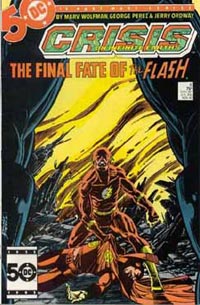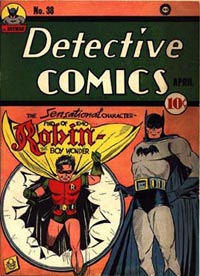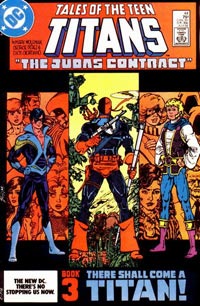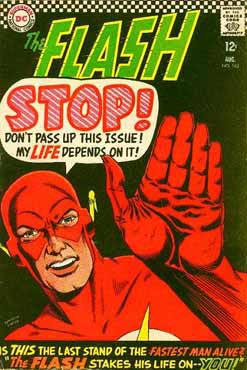|
|
 |
Well, he was a police scientist. His crime fighting experience was among the test tubes and fingerprints, instead of on the mean streets of Central City. It would take William Peterson and the Las Vegas crime lab to give the Flash's alter ego any potential curb appeal. But that was almost 20 years after Barry met his fate in the pages of Crisis on the Infinite Earths, and his former sidekick, Wally West, would assume the mantle of the Scarlet Speedster, if only for a limited time.
Hyping the 2006 Infinite Crisis, DC editorial dropped hints by coyly remarking, "Nothing says Crisis like a dead Flash." Would Wally West die? Would Barry Allen return from the dead? Or would the original Flash, Jay Garrick, be among the casualties of the latest universe-spanning catastrophe?
For those not in the know, Wally became "one with the Speedforce," which is not to say he died, but he has been removed from the DCU. But the Flash lives on in the form of Bart Allen, Barry's descendant from the future.
 |
Despite some imaginary stories of the 1950s, Robin wasn't likely to take over the Batman role anytime in the future. In the early 1980s, while leading the Teen Titans, the Boy Wonder's relationship with the Dark Knight was all but severed. As far as the Bat-office was concerned, his role in the DCU was entirely up to New Teen Titans creators Marv Wolfman and George Perez.
In 1984, it was inevitable that Dick Grayson create his own grown-up super-hero identity.
 |
But having owned and marketed the Robin character for more than 40 years, DC was not about to simply allow the red and green costume to become a relic in the shadows of the Batcave. A new Robin was christened, another orphaned circus boy by the name of Jason Todd. Later, Jason would be ret-conned into a street kid with an attitude, and get bludgeoned to death by the Joker in the infamous 1-900 phone-in stunt. A third Robin, Tim Drake, would eventually adopt the Robin identity.
But 20 years later, another Crisis appeared over the horizon. Once again, Dick Grayson's demise was on the table, but allegedly the fan boy passion of writer Geoff Johns for the former Boy Wonder stayed the executioner's hand. When word leaked out that it had even been planned, DC’s editorial staff was surprised that one of its "oldest" characters had such a devoted fan following.
Fictional characters develop a life of their own, and it is easy to quantify that, "Yes, Sherlock Holmes would do that," or "No, Han Solo wouldn't do that." But just as living, breathing people find themselves in a rut from time to time, so to do fictional ones. A new job, a life-changing event, maybe even just a new set of clothes, can all contribute to making a new beginning.
Killing off a character is hardly a solution to the real problem of being able to write a good, entertaining story. Such a stunt has been justifiably decried “gimmick” to boost sales. Often it is accompanied by the thought from comic book writers that a character's death must have meaning – meaning that an editorial decision has been made to pass the super-hero mantle on to a younger, hipper character.
When Green Lantern died, Kyle Rayner inherited the guardianship of space sector 2418. When Oliver Queen blowed up real good, the Green Arrow name was passed on to his unknown son Connor Hawke. And when Barry Allen’s time ran down, the baton was passed to his former protegé Wally West.
Nevertheless, Oliver Queen and Hal Jordan have returned from the Hereafter. Their resurrections were made viable by the fact that their respective fan bases were interested in them. Perhaps it is unfair to say that Barry Allen had become boring; it may have been the writers who made him so, or failed to make him relevant.
 |
None of this is my argument for bringing him back. This is just my oh-so-tardy defense in killing him off in the first place. Not that it would've done much good back in '86. DC wasn't about to listen to me then any more than they are now. But thanks to the Internet and a vocal fan base, other characters may escape the clammy touch of Death (or ret-con, call it what you will) a while longer.
Hopefully it signals the end of that particular solution for "boring characters."
Praise and adulation? Scorn and ridicule? E-mail me at philip@comicbookbin.com.
© Copyright 2002-2019 by Toon Doctor Inc. - All rights Reserved. All other texts, images, characters and trademarks are copyright their respective owners. Use of material in this document (including reproduction, modification, distribution, electronic transmission or republication) without prior written permission is strictly prohibited.

